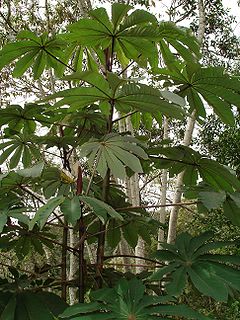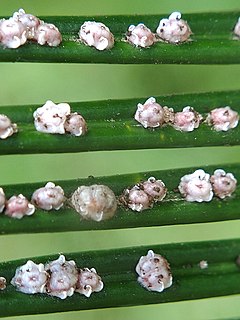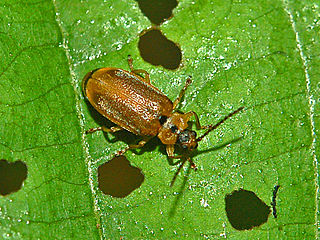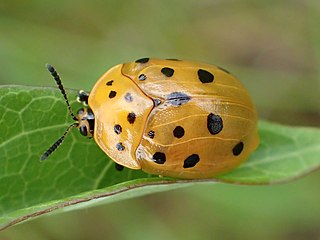
Cecropia is a Neotropical genus consisting of 61 recognized species with a highly distinctive lineage of dioecious trees. The genus consists of pioneer trees in the more or less humid parts of the Neotropics, with the majority of the species being myrmecophytic. Berg and Rosselli state that the genus is characterized by some unusual traits: spathes fully enclosing the flower-bearing parts of the inflorescences until anthesis, patches of dense indumentums (trichilia) producing Mullerian (food) at the base of the petiole, and anthers becoming detached at anthesis. Cecropia is most studied for its ecological role and association with ants. Its classification is controversial; in the past, it has been placed in the Cecropiaceae, Moraceae, or Urticaceae. The modern Angiosperm Phylogeny Group system places the "cecropiacean" group in the Urticaceae.

The tansy beetle is a species of leaf beetle. It measures 7.7–10.5 mm in length and has a characteristic bright metallic green colouration. The common name derives from the tansy plant on which they often feed as both larvae and adults. In addition to the nominotypical subspecies, which repeats the specific name, C. graminis graminis, there are five further distinct subspecies of tansy beetle, which, collectively, have a Palearctic distribution, although in the majority of countries where it is found the species is declining. In the United Kingdom it is designated as 'Nationally Rare' and this localised population, centred on York, North Yorkshire, has been the subject of much recent research.

Scale insects are small insects of the order Hemiptera, suborder Sternorrhyncha. Of dramatically variable appearance and extreme sexual dimorphism, they comprise the superfamily Coccoidea. Adult females typically have soft bodies and no limbs, and are concealed underneath domed scales, extruding quantities of wax for protection. Some species are hermaphroditic, with a combined ovotestis instead of separate ovaries and testes. Males, in the species where they occur, have legs and sometimes wings, and resemble small flies. Scale insects are herbivores, piercing plant tissues with their mouthparts and remaining in one place, feeding on sap. The excess fluid they imbibe is secreted as honeydew on which sooty mold tends to grow. The insects often have a mutualistic relationship with ants, which feed on the honeydew and protect them from predators. There are about 8,000 described species.

Histeridae is a family of beetles commonly known as clown beetles or Hister beetles. This very diverse group of beetles contains 3,900 species found worldwide. They can be easily identified by their shortened elytra that leaves two of the seven tergites exposed, and their elbowed antennae with clubbed ends. These predatory feeders are most active at night and will fake death if they feel threatened. This family of beetles will occupy almost any kind of niche throughout the world. Hister beetles have proved useful during forensic investigations to help in time of death estimation. Also, certain species are used in the control of livestock pests that infest dung and to control houseflies. Because they are predacious and will even eat other Hister beetles, they must be isolated when collected.

The Australian owlet-nightjar is a nocturnal bird found in open woodland across Australia and in southern New Guinea. It is colloquially known as the moth owl. It is the most common of the owlet-nightjars, and the best known of this secretive family. It is the most common nocturnal bird in Australia, and despite suffering from predation and competition by introduced species it is not considered threatened.

The scarlet lily beetle, red lily beetle, or lily leaf beetle, is a leaf beetle that eats the leaves, stem, buds, and flowers, of lilies, fritillaries and other members of the family Liliaceae. It lays its eggs most often on Lilium and Fritillaria species. In the absence of Lilium and Fritillaria species, there are fewer eggs laid and the survival rate of eggs and larvae is reduced. It is now a pest in most temperate climates where lilies are cultivated.

Charidotella sexpunctata, the golden tortoise beetle, is a species of beetle in the leaf beetle family, Chrysomelidae. It is native to the Americas.

Xanthogaleruca luteola, commonly known as the elm-leaf beetle, is a beetle species in the family Chrysomelidae that is native to Europe but invasive in other parts of the world.

Jalmenus evagoras, the imperial hairstreak, imperial blue, or common imperial blue, is a small, metallic blue butterfly of the family Lycaenidae. It is commonly found in eastern coastal regions of Australia. This species is notable for its unique mutualism with ants of the genus Iridomyrmex. The ants provide protection for juveniles and cues for adult mating behavior. They are compensated with food secreted from J. evagoras larvae. The ants greatly enhance the survival and reproductive success of the butterflies. J. evagoras lives and feeds on Acacia plants, so butterfly populations are localized to areas with preferred species of both host plants and ants.

Clytra laeviuscula, the ant bag beetle, is a species of short-horned leaf beetles belonging to the family Chrysomelidae, subfamily Cryptocephalinae.

Galerucella calmariensis is a species of leaf beetle in the family Chrysomelidae. It is commonly known as the black-margined loosestrife beetle and is native to Europe and Asia where both adults and larvae feed on purple loosestrife. It has been introduced in North America as a biological control agent for purple loosestrife.
Azteca andreae is an arboreal ant species found in the tropics of South America, most notably in French Guiana. They are most notable for their predatory skills and strength. They are ambush predators that are able to capture and eat other insects much greater than their own size.

Galerucella is a genus of leaf beetles in the family Chrysomelidae described by George Robert Crotch in 1873. It is widely distributed but absent in the Neotropics.Some species feed on waterlilies and are used as biocontrol of introduced, invasive waterlilies. Galerucella tenella feed on strawberry plants.

Gratiana boliviana is a species of beetle in the leaf beetle family, Chrysomelidae. Its common name is tropical soda apple leaf beetle. It is native to South America, where its distribution includes Argentina, Brazil, and Paraguay. It specializes on tropical soda apple, an invasive plant species. It has been released as an agent of biological pest control against the weedy plant in Florida and other parts of the United States.

Azteca alfari is a species of ant in the genus Azteca. Described by Carlo Emery in 1893, the species is widespread in Mexico, Central and South America. This ant has a mutualistic relationship with a Cecropia tree. The specific name alfari honours a Costa Rican zoologist Anastasio Alfaro.

Pleometrosis is a behavior observed in social insects where colony formation is initiated by multiple queens primarily by the same species of insect. This type of behavior has been mainly studied in ants but also occurs in wasps, bees, and termites. This behavior is of significant interest to scientists particularly in ants and termites because nest formation often happens between queens that are unrelated, ruling out the argument of inclusive fitness as the driving force of pleometrosis. Whereas in other species such as wasps and bees co-founding queens are often related. The majority of species that engage in pleometrosis after the initial stages of colony formation will reduce their colonies number of queens down to one dominant queen and either kill or push out the supernumerary queens. However there are some cases where pleometrosis-formed colonies keep multiple queens for longer than the early stages of colony growth. Multiple queens can help to speed a colony through the early stages of colony growth by producing a larger worker ant population faster which helps to out-compete other colonies in colony-dense areas. However forming colonies with multiple queens can also cause intra-colony competition between the queens possibly lowering the likelihood of survival of a queen in a pleometrotic colony.
Raphidopalpa foveicollis, the red pumpkin beetle, is a species of beetle in the family Chrysomelidae. It is a foliar pest of members of the Cucurbitaceae, particularly the pumpkin.

Chelymorpha cassidea, known generally as the Argus tortoise beetle or milkweed tortoise beetle, is a species of leaf beetle in the family Chrysomelidae. It is found in the Caribbean and North America.

Cecropia pachystachya, commonly known as Ambay pumpwood, is a species of tree in the family Urticaceae. It is native to Argentina, Paraguay and Brazil where it grows near the edges of moist forests.

Azteca muelleri is a species of ant in the genus Azteca. Described by the Italian entomologist Carlo Emery in 1893, the species is native to Central and South America. It lives in colonies in the hollow trunk and branches of Cecropia trees. The specific name muelleri was given in honour of a German biologist Fritz Müller, who discovered that the small bodies at the petiole-bases of Cecropia are food bodies.

















